How to Make a Toilet Flush Better? (5 Simple Steps)
Author: Omar Alonso | Editor: Omar Alonso
Review & Research: Jen Worst & Chris Miller

Are you flushing the toilet multiple times to clear it? That can be a sign of bigger problems in your plumbing system, or more often you just need to know how to make your toilet flush better. We have several strategies are available to help you resolve the issue.
How to Make a Toilet Flush Better? – A Step-by-Step Guide
Follow this step-by-step guide on how to increase your toilet flush pressure. You'll find it gives the throne a bigger and better whoosh!
1) Inspect for Clogs & Remove Them
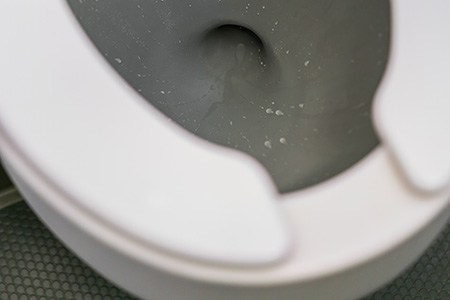
Toilets get clogged all the time; it's just part of being a homeowner. Some clogs go away naturally in a few hours, and others require physical intervention. If your toilet gets clogged, leave it to drain by itself for an hour. If the toilet still doesn't flush properly, grab the plunger.
Position whatever type of plunger over the toilet bowl and give it a few big pumps. Remove the plunger and flush the toilet. If that doesn't work, call a plumber. The plumber uses a "snake" to reach around the U-bend in the toilet and release the clog.
Or you could try making a snake using an old wire clothes hanger. Unravel it and work it into the U-bend until you release the clog.
2) Inspect & Clean the Bowl Jets
If you find black mold spores in your toilet jets around the rim, you might have clogged jets weakening the toilet's flushing power. Mold and sediment buildup in the jets from hard water sources can cause the jets to clog and operate inefficiently.
Clogged jets reduce flushing power significantly, and you'll need to free them up to restore the toilet to normal use. You can use a pipe cleaner to clean the individual jets and release materials or mold clogging them. A paper clip or toothpick also works for this task.
3) Inspect the Water Level in the Tank
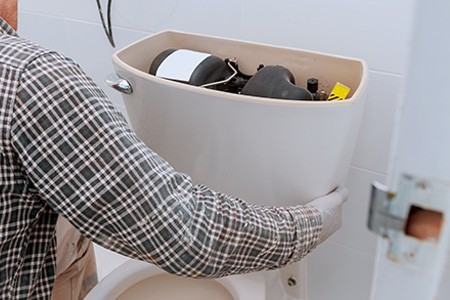
If the first two hacks didn't improve the toilet flushing power, open the tank. Flush the toilets and inspect the operation of the individual components in the tank. Start by removing the lid and placing it on the ground. You don't want the cover to fall off the seat while you're working and crack, causing the need for a costly replacement.
Next, look at the water level in the tank and ensure it's at the right level. There's usually a water line marked by the manufacturer on the rim inside of the tank. If you can't see a marking, the water itself should create a stain on the inner edge of the tank, giving you an idea of where it normally sits.
Fixing low water in the tank is one of the most common answers to how to make a toilet flush better. You'll have less pressure due to not enough volume pushing down thanks to gravity.
If the tank isn't filling to the waterline, it could be an issue with the float or drain valve. The rule of thumb is for the water to sit a half-inch below the flush valve. The float is usually made from plastic and requires replacement every five years. If you don't replace it, water eventually gets in and starts to sit lower than it should.
4) Inspect the Flush Valve & Chain
Examine the chain in the tank. If the chain is too long, it catches underneath the fill valve, causing it to remain in the open position. As a result, the water filling the tank runs continuously into the bowl, and the tank doesn't fill properly.
As a result, you don't get sufficient water pressure when flushing the toilet. If you notice the sound of running water coming from the bathroom at night, it's usually a sign the toilet is leaking from the tank into the bowl. It might be due to the tank leaking or a faulty or cracked overflow valve. Often you'll have the toilet water rising and then slowly draining in the bowl over and over.
Fix this problem by ensuring the chain has enough tension to close the flapper (flush valve). Ensure that there isn't too much tension on the chain, or it causes a similar problem. Examine the flush handle where it attaches to the chain.
The chain should pull directly above the handle with minimal slack. Typically, you're looking for around ¼ to ⅓ inch of play on the chain at most. The chain should open the flapper fully when you push the flush lever. You get the best results when the chain pulls the flapper vertically upwards.
If there's too much chain, the flapper closes early. Limiting the water entering the bowl and creating a weak flush. If you have a toilet using a dual-flush system, such as a high-efficiency or low-flow model, ensure it's flushing the right amount of water into the bowl.
Inspect the buttons on the dual flush model and ensure they line up with the flush valves. These models are ideal for conserving water, but it creates a weak flush if they don't allow enough water from the tank to the bowl.
5) Inspect the Bowl Water Line
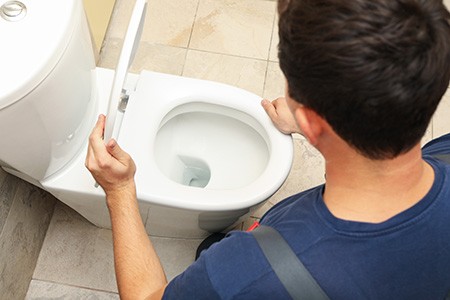
If the toilet bowl doesn't have sufficient water in it, you get a weak flush. To ensure it's filling correctly, fill a bucket with water and slowly pour it into the bowl.
At a certain point, the water level stops rising. This position indicates the level the water line must reach when the tank empties into the bowl.
Note the level in the bowl using a sharpie. Flush the toilet, and if the water doesn't reach that level, you probably have a faulty flow valve requiring replacement. Water level is critical in how to get more flushing power from your toilet, so you'll have to fix this.
Cleaning Tips to Improve Toilet Flushing Power
You might think you need to adjust your toilet tank float, but often times you have jets becoming clogged. Even if not, cleaning them out is essential in how to make a toilet flush better than it was. Let’s look at some cleaning methods to make sure your water is flowing free.
Chemical Cleaning – Use Bleach in the Toilet Bowl
Keeping your toilet bowl clean prevents clogs and ensures optimal toilet operation with every flush. Turn off the water supply line to the tank by closing the valve on the line; you'll usually find it behind the toilet.
Pour a gallon of bleach into the bowl and open the bathroom windows to let the fumes escape. Leave the bleach to sit in the bowl for 30 to 45 minutes, and the corrosive nature of the chemical frees up clogs or blockages, causing an inefficient flush.
After time expires, flush the toilet, and the bleach removes and clogs or resides on the edges of the plumbing and pipework. Open the water valve, let the toilet refill, and replace the lid. Flush the toilet again to ensure no bleach remains in the bowl.
Natural Cleaning – Use Vinegar in the Water Tank
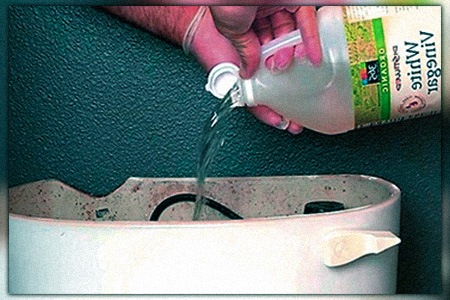
Keeping the tank clean ensures optimal operation of the flapper and other flush components. Remove the tank lid and place it on the floor. Turn off the water valve and flush the toilet to remove all the water in the tank.
Fill the tank with white spirit vinegar up to the top of the flapper. Let the vinegar sit in the toilet tank for two to three hours. Once again, open all the windows in the bathroom to let the smell escape. We recommend replacing the lid while you wait, or it stinks out of the bathroom with an acidic vinegar smell.
It's also important to tell other occupants in your home when you fill the tank or bowl with vinegar or bleach. The longer you leave the vinegar in the tank, the better the chance of removing clogs, scum, or dirt blocking the flushing components in the tank.
Vinegar effectively loosens and removes any sediment buildup from hard water sources. It's an affordable cleaning agent, and it works well. After you finish, flush the toilet. Turn on the water supply valve and let it refill the tank, then flush it again.
If needed, you can always use a credible plumber with a good reputation in your community. Ensure you hire someone willing to guarantee their work. They know exactly how to increase flushing power.
FAQs on How to Improve Your Toilet Flush Strength
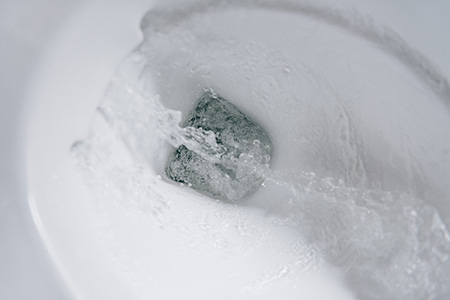
When people ask how to make a toilet flush stronger, a lot of other questions come up. Let’s cover those now.
What Are the Common Problems Affecting Toilet Flushing Power?
Common issues causing low flushing power in your toilet include clogs in the U-bend, worn flappers, waterlogged floats, problems with the chain and handle, and blocks in the rim jets.
Do Some Toilets Flush Better Than Others?
New toilet designs, like low-flow models, provide better water efficiency when flushing the toilet. However, they might become faulty and not provide enough water pressure from the tank when flushing. If you don't have experience working with these toilets, call a plumber for assistance with resolving the weak flushing issue.
Why Does the Toilet Drain Slowly After Flushing?
Typically, a slow-draining toilet is a sign of a clog. If the toilet drains slowly, usually, the clog is minor and resolves itself in a few hours. However, if the clog persists, it may back the water onto the floor. If that's the case, you'll have to use a plunger or a plumbers snake to release the clog and return the toilet to normal operation.
Key Takeaways to Increase Your Toilet Flush Power
- If your toilet has a weak flush, it could be due to one of five problems or a combination.
- Most issues with your toilet's low flushing power are easy to resolve yourself.
- Use an unwound wire hanger if you don't have a plumbing snake on hand to free a clog.
- Most of the issues with poor flushing come from the tank and involve problems with the float, flapper, handle, and chain.
- Clogged rim jets can also cause issues with weak flushes.
And That’s How to Make a Toilet Flush Better
Assuming you’re not having any larger issues, the process for how to make a toilet flush better is simple. Clear any clogs, clean the jets, and set the water level in the tank properly. That’s it, and none are difficult to achieve. Within even 20 minutes you can fix your toilets issues once you know what to do by following our guide above.



